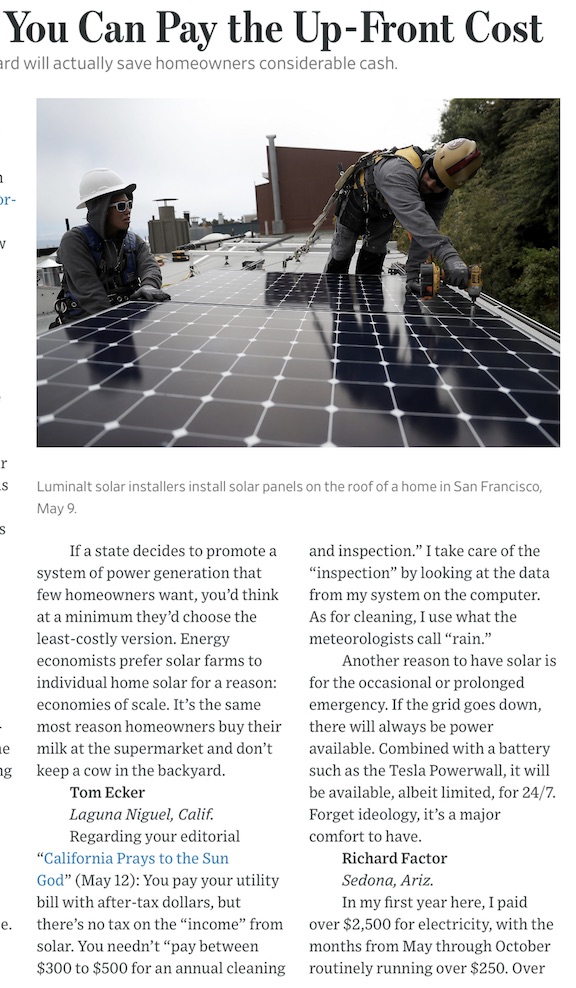RIKLBLOG
|
| Tomorrow |
| 25 June 2018 |
| Yesterday |
| Index |
| Eventide |
| SETI League |
| PriUPS Project |
| Bonus! |
| Contact |


Try to NOT Build a Solar House in California
I read an article, widely reported, that California is now requiring new houses to incorporate solar panels on the roof. How many chains does this pull? How many freedom-from-government oxen are gored? When I read a version of the article in the Wall Street Journal, I just knew that the pros and the antis would have a field day writing to the editor in approval or horror.
The Solar Brigade Strikes
Of course, I had to be one of them. But was I a pro or an anti? Tough question! I'm not keen on government ukases, no matter how benevolent. But I felt that it was a swell idea nonetheless, since I'm a firm believer in the advantages of solar power. I solved the problem by writing the letter below. Although the editor slightly paraphrased my comments with a pithy "forget ideology," I was content with the result. Any number of additional solar brigade members endorsed, in different ways, my theory. A few didn't, for "balance."

Try TO Build a Solar System in New Jersey
I've had a solar system at home in Sedona for several years and you won't be surprised to discover I love it! In fact, I love it so much that I felt we needed one at my place of striving. After some discussion, sizing, roof checks, quotes, and the usual pre-construction work, we obtained a very nice installation which will help reduce our electric bill. But the above words obscure some difficulties that we encountered.
As with almost all construction, one must obtain a permit from the locality. Our particular locality has a negative relationship with sea level, and it is only by the grace of Sandy that we managed to avoid flooding. Solar power, which is independent of the electric grid, requires a manual cutoff switch that utility workers can reach in an emergency so that they can be assured power is off. Given the possibility of flooding, the town required that this cutoff switch be placed somewhat higher on the building than is customary, and that is where our installer located it. So far so good.
When the power company came to inspect and approve the installation, they looked at the switch location and decided that it was too high and their people couldn't reach it. I could, barely, so I suggested that in an emergency, they simply send a person at least as tall as I. This eminently practical suggestion was rejected, as was even the more practical suggestion of "how about attaching a stick to the switch so anyone could reach it." Nope, it either had to be lowered, or we had to build a platform under it.
To ennutshellize, it went like this:
- Build and test solar system
- Call power company for permission to turn on
- Get rejected by power company until we built a platform
- Design and get permit from town to build platform
- Build platform
- Have power company come to approve installation
- After approval, wait for power company to order a meter and install it*
- Turn on system and watch the kilowatt hours flow
If you know your bureaucracy, you won't be surprised that it took about three months, almost all of which was waiting for inspectors and bureaucrats, to turn the system on after it was fully installed and tested. That's quite a few megawatt hours totally wasted, mostly at the behest of a utility that wants to be considered "green" but can't even afford to hire tall emergency workers, or better, allow us to use a stick.
Grrrr. Just grrrr.
* When I heard this, I was incredulous. This particular power company serves literally millions of customers, and, undoubtedly, many thousands of solar installations. They have to order a meter because none is in stock? Perhaps I misunderstood. Perhaps not.
| © 2018 |
| Richard Factor |
NP:
|
|
TotD Grice is apparently defunct, merged, or missing, but not forgotten, at least not if I ever wear this somewhat tattered shirt. It probably doesn't fit any more, alas. |
 |